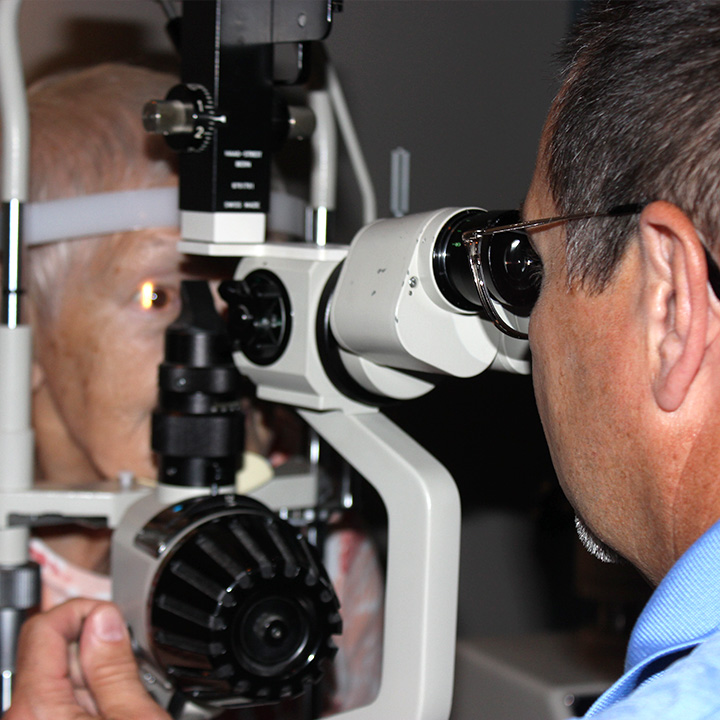The doctors at Opticare participate in the diagnosis and treatment of many eye diseases as well as ocular complications from systemic diseases and disorders. These services are performed within our clinic and by other doctors with whom we partner. Below are some of the more common diseases we treat.
Cataracts
A cataract is clouding of the crystalline lens inside the eye. A cataract causes loss of detail vision at near and far, even with your glasses on. Cataracts also cause problems with glare in certain lighting conditions. Cataracts can happen at any age but are much more common as we get older. The doctors at Opticare check for cataracts, along with many other eye diseases, every time we examine your eyes.
Glaucoma
Glaucoma is a disease that damages the optic nerve and initially causes loss of vision in the mid-periphery, progressing to complete loss of vision if left untreated. It is usually caused by elevated pressure within the eyes. If a person waits until they notice a loss of vision from glaucoma, they have lost 50% or more of the healthy fibers of the optic nerve, and these cannot be replaced. This makes early detection of utmost importance.
We detect and monitor glaucoma by checking the pressure in your eyes, by checking your peripheral vision, and by watching for changes in the optic nerve head and surrounding structures.
People with a close family member who has glaucoma have a higher risk of developing the disease. Additional risk factors include recent eye trauma, elevated eye pressure, use of steroid and other medications, ethnic factors, older age, and other factors.
Macular Degeneration
Macular degeneration is an eye disease that affects some people as they get older.
If a person develops macular degeneration, their first symptom of the disease will likely be a distortion at the center of their vision. Lines that are straight may appear bent or squiggly and letters may appear distorted when they look right at them. If the disease progresses, small patches of central vision may disappear completely. Further progression would result in these patches of missing vision joining together to form a larger area of central vision loss. Even in its most severe presentation, people with macular degeneration retain relatively normal peripheral vision.
We generally think of macular degeneration in two forms—dry and wet. In the dry form, the central retina begins to deteriorate with the formation of small white deposits and clumping of the retinal pigment.
If the disease converts to the wet form, in addition to the deposits and pigment clumping, there will be leakage of fluid or bleeding into the retina. If this occurs, medication can be placed in the eye to seal the leaking vessels and put the condition back into the dry form.
It is good to take precautions for a person’s entire life to prevent macular degeneration. Protecting one’s eyes from excessive ultraviolet (UV) radiation helps prevent the disease. In addition, anything you can do to optimize your cardiovascular health is protective against macular degeneration. Staying active and maintaining a healthy weight is helpful. Cigarette smoking roughly quadruples a person’s risk of blindness from macular degeneration, mainly because of its effect on blood vessels. Nutrition also affects the likelihood of developing the disease. In general, diets rich in green, yellow, and orange vegetables are helpful with prevention. Egg yolks contain high amounts of the mineral lutein, which has shown to benefit in protecting the eyes. Fish, flax, nuts, and other foods rich in omega 3 fatty acids appear to be preventive as well.
Some patients are recommended to take a vitamin/mineral supplement rich in vitamins A, C, E, the minerals zinc, lutein, zeaxanthin, and possibly an omega 3 supplement. There are some restrictions on who can receive these supplements, so this must be coordinated between each patient, the eye doctor, and their primary care provider.
Diabetes
Diabetes can have significant manifestations in the visual system. The earliest symptom of diabetes can be transient distance blur due to fluctuations in blood sugar levels. Diabetes also can cause damage to the retina that can lead to blindness. Diabetes can cause damage to the nerves that lead into and out of the eyes and eye muscles causing decreased vision, double vision, and pupil abnormalities. When we monitor your eyes for signs of diabetes, we provide our findings to your primary care doctor so that your diabetic care can be optimized to minimize the ocular manifestations of diabetes.
PRI Vision Therapy
Postural Restoration Institute Vision Therapy utilizes specific lens combinations in the patient’s glasses that influence body posturing in order to function in a position of neutrality. A neutral body position is one that relaxes the muscles so the joints are not in a constant position of stress which oftentimes leads to joint pain, stiffness, or headaches. We can positively influence body position with eyeglasses simply because 70% of all neural connections in the brain contain visual information. We offer coordinated care with trained physical therapists in order to ensure synergy between the eyes and the body with the goal of relieving pain in specific locations of the body.



